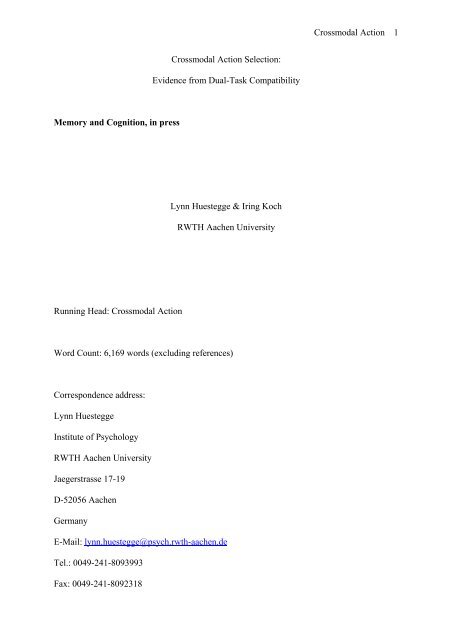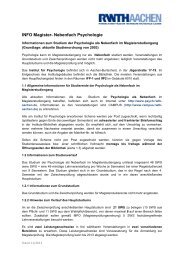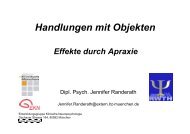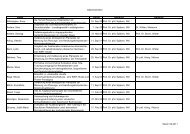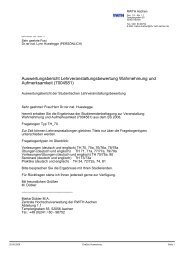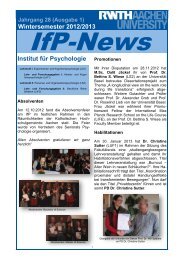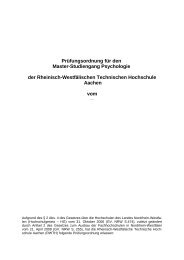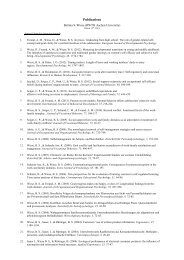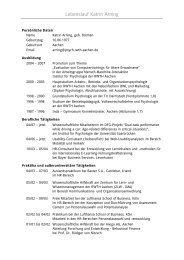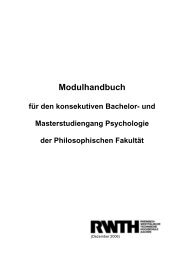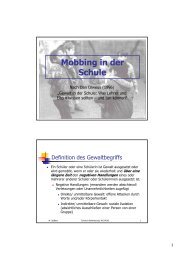Crossmodal Action 1 Crossmodal Action Selection - RWTH Aachen ...
Crossmodal Action 1 Crossmodal Action Selection - RWTH Aachen ...
Crossmodal Action 1 Crossmodal Action Selection - RWTH Aachen ...
Create successful ePaper yourself
Turn your PDF publications into a flip-book with our unique Google optimized e-Paper software.
<strong>Crossmodal</strong> <strong>Action</strong> 1<br />
<strong>Crossmodal</strong> <strong>Action</strong> <strong>Selection</strong>:<br />
Evidence from Dual-Task Compatibility<br />
Memory and Cognition, in press<br />
Lynn Huestegge & Iring Koch<br />
<strong>RWTH</strong> <strong>Aachen</strong> University<br />
Running Head: <strong>Crossmodal</strong> <strong>Action</strong><br />
Word Count: 6,169 words (excluding references)<br />
Correspondence address:<br />
Lynn Huestegge<br />
Institute of Psychology<br />
<strong>RWTH</strong> <strong>Aachen</strong> University<br />
Jaegerstrasse 17-19<br />
D-52056 <strong>Aachen</strong><br />
Germany<br />
E-Mail: lynn.huestegge@psych.rwth-aachen.de<br />
Tel.: 0049-241-8093993<br />
Fax: 0049-241-8092318
<strong>Crossmodal</strong> <strong>Action</strong> 2<br />
Abstract<br />
Response-related mechanisms of multitasking were studied by analyzing simultaneous<br />
processing of responses in different modalities (i.e., crossmodal action). Subjects responded to<br />
a single auditory stimulus either with a saccade, a manual response (single-task conditions), or<br />
both (dual-task condition). We used a spatially incompatible stimulus-response mapping for<br />
one task but not for the other. Critically, inverting these mappings varied temporal task<br />
overlap in dual-task conditions while keeping spatial incompatibility across responses<br />
constant. Unlike previous paradigms, temporal task overlap was manipulated without utilizing<br />
sequential stimulus presentation, which might induce strategic serial processing. The results<br />
revealed dual-task costs, but these were not affected by an increase of temporal task overlap.<br />
This finding is evidence for parallel response selection in multitasking. We propose that<br />
crossmodal action is processed by a central mapping-selection mechanism in working<br />
memory, and that the dual-task costs are mainly caused by mapping-related crosstalk.<br />
Keywords: Dual-Task Interference, Task Dominance, Stimulus-Response Compatibility,<br />
Saccades, Manual Responses, Crosstalk
<strong>Crossmodal</strong> <strong>Action</strong> 3<br />
Numerous studies demonstrated that multitasking leads to poorer performance when<br />
compared with the execution of one task alone (e.g., Pashler, 1994). Typically, multitasking<br />
research focuses on 1.) manipulating the temporal relation of two tasks by systematically<br />
varying their temporal overlap (psychological refractory period [PRP] paradigm, Welford,<br />
1952; see Pashler, 1994, for a review), or on 2.) comparing single-task performance with<br />
performance in trials where the stimuli for both tasks are presented at the same time (dualtask<br />
paradigm; e.g., Navon & Miller, 1987). The present study combines both approaches:<br />
We utilized a single stimulus for both tasks to gain suitable control over stimulus-related<br />
processes and varied the spatial stimulus-response mappings across tasks to manipulate<br />
temporal task overlap. Using this novel experimental approach yielded evidence for parallel<br />
response selection in multitasking.<br />
In the PRP paradigm, the manipulation of stimulus onset asynchrony (SOA) between<br />
both tasks induces a systematic variation of temporal task overlap. As a result, more overlap<br />
(i.e., shorter SOA) leads to a prolongation of response times (RTs) in the second task, but not<br />
in the first task (i.e., the PRP effect; Welford, 1952). More specifically, at short SOAs every<br />
further decrease of SOA is associated with an almost equal increase of RTs in the second task.<br />
The PRP effect has been explained in terms of a central response-selection bottleneck in<br />
cognitive processing (Pashler, 1994). Within the bottleneck model, task processing is<br />
conceived of as a series of distinct stages, such as perceptual processing, response selection,<br />
and response execution. Empirical evidence from numerous PRP studies involving the<br />
experimental manipulation of the various processing stages in both tasks suggested that<br />
primarily the response selection stage acts as a central bottleneck. More specifically,<br />
according to such an account response selection must be devoted to only one response at a<br />
time, so that processing of the second task is suspended until response selection in the first<br />
task has been finished (Pashler, 1994). This serial central processing account thus serves as a<br />
straightforward explanation of the PRP effect. The PRP effect occurs even when sensory and
<strong>Crossmodal</strong> <strong>Action</strong> 4<br />
motor modalities are distinct for the two tasks (e.g., an auditory-manual Task 1 and a visualvocal<br />
Task 2), suggesting that the central response selection stage is basically an amodal<br />
origin to the dual-task costs (e.g., Marois & Ivanoff, 2005; but see Hazeltine, Ruthruff, &<br />
Remington, 2006). More recent models of multitasking extended the central bottleneck model<br />
to account for more complex multitasking situations (e.g., Byrne & Anderson, 2001; Salvucci<br />
& Taatgen, 2008), but the core idea of serial central processing remained untouched.<br />
A major advantage of the PRP paradigm is the possibility of manipulating temporal<br />
task overlap to study mechanisms of multitasking. However, it was argued that the PRP effect<br />
might specifically arise due to the successive stimulus presentation, suggesting strategic serial<br />
response processing to the participants (see Meyer & Kieras, 1997). This possibility might<br />
compromise any generalization to settings where stimuli are not separated by a given time lag,<br />
and thus the PRP paradigm is not suited to finally answer the question of whether response<br />
selection can be accomplished in parallel. Furthermore, the PRP paradigm only captures a<br />
portion of performance costs in multitasking. For example, PRP studies that additionally<br />
included single-task controls demonstrated that RT1 and RT2 in PRP trials are (at any SOA)<br />
longer than the respective single-task RTs (e.g., Herman & Kantowitz, 1970; Hommel, 1998;<br />
Pashler, 1984), suggesting further sources of performance costs in multitasking beyond<br />
central response selection bottlenecks.<br />
By comparison, in the dual-task paradigm dual-task costs are typically assessed by<br />
subtracting RTs in single-task conditions from RTs in dual-task conditions (e.g., Navon &<br />
Miller, 1987). A major advantage of the dual-task paradigm is that the simultaneous<br />
presentation of stimuli in dual-task conditions does not suggest a serial response planning<br />
strategy to the participants. A major drawback, however, is that this procedure does not allow<br />
one to manipulate temporal task overlap, thus limiting the scope regarding the analysis of<br />
underlying mechanisms of multitasking. Additionally, while some portion of the dual-task<br />
costs in the dual-task paradigm might be specifically related to central bottlenecks or central
<strong>Crossmodal</strong> <strong>Action</strong> 5<br />
resource limitations (similar to costs in the PRP paradigm), some other portion appears to be<br />
due to other factors, such as crosstalk (see below), or more general concurrence costs (e.g.,<br />
expectancies) of performing two tasks at a time (see Logan & Gordon, 2001). For example,<br />
Gottsdanker (1979) demonstrated that RTs were slowed substantially when the stimulus of a<br />
secondary task was expected but did not appear. Thus, the dual-task paradigm does not allow<br />
one to separately assess the various sources of performance costs in multitasking.<br />
Similar to the PRP effect, performance costs in the dual-task paradigm are also often<br />
more pronounced in one task than in the other task (e.g., Fagot & Pashler, 1992; Navon &<br />
Miller, 1987). A possible account of such differences in performance costs can be built upon<br />
the assumption that single-task processing speed determines the pattern of performance costs<br />
in multitasking. This assumption was first developed within the context of the Stroop effect<br />
(Stroop, 1935; Posner & Snyder, 1975; but see MacLeod, 1991, for a critical discussion).<br />
More specifically, the effects of single-task processing speed on dual-task performance in the<br />
dual-task paradigm can be derived within the central bottleneck framework (Pashler, 1994).<br />
Similar single-task processing speed of two tasks implies larger temporal task overlap in the<br />
dual-task situation and should thus increase the amount of temporal overlap of response<br />
selection stages (everything else being equal). When we assume that the system schedules the<br />
slower task to come second (e.g., because this speeds overall completion time, measured<br />
across both tasks), this should lead to a postponement of response selection in the slower task,<br />
resulting in greater dual-task costs as compared with a situation with smaller temporal task<br />
overlap. In the latter case, response selection in the faster task should in many cases be<br />
already completed before processing in the slower task enters the bottleneck, minimizing the<br />
potential for dual-task costs. In sum, the central bottleneck account predicts substantially<br />
greater dual-task costs in the dual-task paradigm when both tasks show similar single-task RT<br />
levels (equivalent to relatively larger temporal task overlap in dual-task conditions) as
<strong>Crossmodal</strong> <strong>Action</strong> 6<br />
compared to dissimilar single-task RT levels (equivalent to relatively smaller temporal task<br />
overlap in dual-task conditions).<br />
Alternatively, more recent accounts of dual-task costs assume that central processing<br />
of both tasks can principally be accomplished in parallel (e.g., Meyer & Kieras, 1997; Navon<br />
& Miller, 2002; Tombu & Jolicoeur, 2003), attributing the typical PRP effect to the specific<br />
situation of sequential stimulus presentation in the PRP paradigm. According to these<br />
accounts, dual-task costs are due to strategic serial processing of tasks (like in the PRP<br />
paradigm), or another source of dual-task interference that may play a role during parallel<br />
processing of responses. More specifically, whenever two tasks with dimensional overlap<br />
(Kornblum, Hasbroucq, & Osman, 1990) are processed (e.g., when both tasks involve a<br />
left/right dimension), this leaves room for crosstalk to occur (Huestegge & Koch, 2009; Koch,<br />
2009; Navon & Miller, 1987). Contrary to the serial bottleneck account, a parallel crosstalk<br />
account would thus not necessarily predict pronounced differences in dual-task costs as a<br />
function of temporal task overlap in the dual-task paradigm as long as the source of crosstalk<br />
(e.g., spatially incompatible responses) within a trial remains constant.<br />
The present study was conducted to directly test these alternative (serial vs. parallel)<br />
accounts of response-related processes in multitasking by combining the strengths while<br />
avoiding the major drawbacks of both the PRP paradigm and the classic dual-task paradigm.<br />
To gain suitable control over stimulus-related processes, we implemented a single onset<br />
paradigm, in which two responses were not only triggered at the same time but also by a<br />
common stimulus (Fagot & Pashler, 1992). By using only one stimulus for both tasks we<br />
ensured that the perceptual analysis of the task-relevant feature is the same for both tasks and<br />
thus is completed for both tasks at the same time. To manipulate temporal task overlap in the<br />
dual-task conditions, we systematically varied the duration of the response selection stages via<br />
different spatial stimulus-response (S-R) mappings (e.g., Sanders, 1998) in the individual<br />
tasks. In the context of dual-task settings with two spatial tasks, the introduction of S-R
<strong>Crossmodal</strong> <strong>Action</strong> 7<br />
incompatibility in one (but not in the other) task leads to cross-task response incompatibility<br />
(Lien & Proctor, 2002). Crucially, this manipulation offers the opportunity to introduce a<br />
comparable amount of prolongation of the response selection stage in each of the two tasks.<br />
Given the assumed amodal nature of response selection (e.g., Marois & Ivanoff, 2005; but see<br />
Hazeltine et al., 2006), inversely implementing S-R incompatibility in either of the two tasks<br />
should affect response selection to a similar extent, while the overall cross-response<br />
incompatibility remains constant (for similar manipulations in another context see Duncan,<br />
1979, and Vu & Proctor, 2006). More specifically, in one condition S-R mappings were<br />
spatially compatible in Task 1 but incompatible in Task 2, whereas in an alternative condition<br />
S-R mappings were incompatible in Task 1 but compatible in Task 2. Such an inverted<br />
response incompatibility paradigm allows us to manipulate the difference in single-task<br />
processing duration while keeping the overall potential for crosstalk (in terms of spatial<br />
response-response incompatibility) constant.<br />
As a prerequisite for a successful manipulation of temporal task overlap within this<br />
paradigm, we utilized two response modalities with highly dissimilar overall RT levels,<br />
namely saccades and manual responses. Typically, saccades are executed much faster than<br />
manual responses (e.g., Mather & Fisk, 1985; Pashler, Carrier, & Hoffman, 1993). The<br />
simultaneous execution of a compatible saccade and an incompatible manual response should<br />
amplify the a priori RT difference between both modalities (equivalent to relatively small<br />
temporal task overlap in dual-task trials), whereas the simultaneous execution of an<br />
incompatible saccade and a compatible manual response should substantially assimilate the<br />
RT levels of both response modalities (equivalent to relatively larger temporal task overlap in<br />
dual-task trials). More specifically, in the condition with smaller temporal task overlap,<br />
subjects responded to a single lateralized auditory stimulus with a spatially compatible<br />
saccade to a pre-specified location on the screen and/or with an incompatible manual<br />
response. In the condition with larger temporal task overlap, this setting was reversed, so that
<strong>Crossmodal</strong> <strong>Action</strong> 8<br />
subjects responded with a spatially incompatible saccade, but with a compatible manual<br />
response. We used auditory stimuli to ensure comparable sensorimotor transformation<br />
processes for both responses (similar levels of input-output modality compatibility; see<br />
Hazeltine et al., 2006).<br />
Unlike previous paradigms, the present procedure allows one to separately assess<br />
different sources of dual-task costs (i.e., central bottleneck and crosstalk). A comparison of<br />
dual-task costs across temporal task overlap conditions should allow us to assess whether<br />
larger temporal task overlap leads to an increase of dual-task costs, as predicted by serial<br />
bottleneck accounts. The contribution of crosstalk to the performance costs should mainly be<br />
reflected in the comparison of single-task vs. dual-task performance. A more elaborate model<br />
of the specific crosstalk mechanism at work will be presented in the discussion section.<br />
In a recent study that also utilized the single onset paradigm in the study of<br />
simultaneously executed saccades and manual responses towards auditory stimuli, we<br />
demonstrated that substantial dual-task costs occur even when both responses were spatially<br />
compatible (Huestegge & Koch, 2009). Additionally, we demonstrated that dual-task costs<br />
substantially increased when the potential for crosstalk between responses was enhanced (e.g.,<br />
by introducing crossed-hands conditions), suggesting that crosstalk is a major determinant for<br />
dual-task costs in crossmodal response demands. However, since we did not experimentally<br />
manipulate temporal task overlap in the previous study, we were not able to decide to what<br />
extent a central bottleneck contributed to the observed performance costs. The present study<br />
was aimed at explicitly examining this issue of serial vs. parallel processing in crossmodal<br />
action selection, complementing on the action side an already existing line of research on<br />
crossmodal attention in perceptual processing (e.g., Spence & Driver, 2004).<br />
Method<br />
Participants
<strong>Crossmodal</strong> <strong>Action</strong> 9<br />
Twenty-four students from <strong>RWTH</strong> <strong>Aachen</strong> University with normal or corrected-tonormal<br />
vision took part in this experiment and were randomly assigned to the small temporal<br />
task overlap group (9 female, mean age = 25 years) vs. large temporal task overlap group (8<br />
female, mean age = 26 years), respectively. They gave informed consent and received credits<br />
for participation.<br />
Apparatus and Stimuli<br />
The participants were seated using a chin rest 67 cm in front of a 21’’ cathode ray<br />
monitor (temporal resolution: 100 Hz, spatial resolution: 1240 x 1068 pixels). The spacebar of<br />
a keyboard was used during calibration routines. Saccade RTs (defined as the interval<br />
between stimulus onset and the initiation of the saccade) were registered using an Eyelink II<br />
system (SR Research, Canada) by measuring the position of the right pupil with a temporal<br />
resolution of 500 Hz and a spatial resolution < 0.022°.<br />
A green fixation cross at screen center as well as two green rectangular squares at 6° to<br />
the left and right of fixation remained present throughout. The size of the fixation cross and<br />
the rectangular saccade targets was 1/3° each. On the keyboard, two keys (“Alt” and right<br />
“Ctrl”) were chosen from the bottom key row as response keys. Subjects responded with their<br />
left and right index fingers. Throughout the experiment, they were wearing headphones for<br />
the presentation of the auditory stimuli, which consisted of 1000 Hz sine waves presented for<br />
50 ms to either the left or right ear with an easily audible intensity.<br />
Procedure<br />
Each trial began with the presentation of the imperative auditory stimulus (50 ms)<br />
either to the left or right ear. Subjects in the small temporal overlap group were instructed to<br />
either respond as fast and accurately as possible by moving their gaze to the spatially<br />
compatible square on the screen (saccade task in single-task blocks), pressing the spatially<br />
incompatible key on the keyboard (manual task in single-task blocks), or both (dual-task<br />
blocks). In the large temporal overlap group, the spatial mapping of responses to the auditory
<strong>Crossmodal</strong> <strong>Action</strong> 10<br />
stimulus was reversed: Participants were instructed to either respond by moving their gaze to<br />
the spatially incompatible square on the screen (saccade task in single blocks), pressing the<br />
spatially compatible key on the keyboard (manual task in single blocks), or both (dual-task<br />
blocks).<br />
In the single manual blocks, subjects were asked to remain fixated on the central<br />
fixation cross. In the conditions that required saccades (saccade task in single and dual-task<br />
blocks), subjects were instructed to return to the central fixation cross after response. Each<br />
subject completed nine blocks consisting of 30 trials each. Within each block, stimuli to the<br />
left and right were presented in a randomized sequence with an interstimulus interval of 3000<br />
ms. Prior to each block, subjects underwent a calibration routine. Subjects performed 30<br />
practice trials at the beginning that were not further analysed.<br />
Design. The variables of response modality (saccade vs. manual response) and task<br />
condition (single vs. dual) were manipulated within subjects, whereas temporal task overlap<br />
(small vs. large) was manipulated between subjects. Subjects performed three identical<br />
sequences of three blocks (e.g., “saccade response (single task)”, “dual task“, “manual<br />
response (single task)”). The order of conditions within each sequence was counterbalanced<br />
across subjects. As dependent variables, we measured RTs and errors for saccades and manual<br />
responses.<br />
Results<br />
In the small overlap group, we discarded 6.6% of trials in the single saccade blocks<br />
and 9.9% of trials in the dual-task blocks because of blinks or calibration problems with the<br />
eye tracker. In the single manual blocks, 6.6% of trials with erroneously executed<br />
simultaneous saccades were excluded.<br />
In the large overlap group, we discarded 4.7% of trials in single saccade blocks and<br />
8.4% of trials in the dual-task blocks because of blinks or calibration problems. In the single
<strong>Crossmodal</strong> <strong>Action</strong> 11<br />
manual blocks, 5.7% of trials with erroneously executed simultaneous saccades were<br />
excluded.<br />
Figure 1a shows the mean RTs of saccades and manual responses in single-task and<br />
dual-task conditions for both the small and large overlap groups. A three-way ANOVA<br />
revealed a significant main effect of modality, F(1,22) = 111.39, p < .001, η p ² = .84,<br />
indicating longer RTs for manual responses (637 ms) as compared to saccades (299 ms).<br />
There was also a significant main effect of task condition, F(1,22) = 69.90, p < .001, η p ² =<br />
.76, indicating longer RTs in the dual-task condition (557 ms) than in the single-task<br />
condition (379 ms), thus showing overall dual-task costs of 178 ms. There was no significant<br />
main effect of temporal task overlap, F(1,22) = 2.22, p > .10.<br />
The interaction of modality and task condition was significant, F(1,22) = 28.49, p <<br />
.001, η p ² = .56, indicating greater dual-task costs for manual responses (289 ms) as compared<br />
to saccades (66 ms). A separate analysis in both groups showed that dual-task costs were<br />
consistently more pronounced in manual responses as compared to saccades (277 ms vs. 57<br />
ms in the small overlap group and 301 ms vs. 76 ms in the large overlap group, both ps <<br />
.001).<br />
The interaction of modality and temporal task overlap was significant, too, F(1,22) =<br />
20.74, p < .001, η p ² = .49. This interaction indicates that the overall difference between<br />
manual and saccade RTs was substantially greater in the small overlap group (485 ms) as<br />
compared to the large overlap group (192 ms). The assimilation of single-task processing<br />
speed (i.e., the reduction of the RT difference between manual responses and saccades in<br />
single-task conditions in the large overlap group compared to the small overlap group)<br />
amounted to 79%, providing evidence for the effectiveness of our between-subjects<br />
manipulation.<br />
Most importantly, overall dual-task costs were virtually the same in both groups (167<br />
ms in the small overlap group vs. 188 ms in the large overlap group), F < 1 for the interaction
<strong>Crossmodal</strong> <strong>Action</strong> 12<br />
of task condition and temporal task overlap, and also the three-way interaction of task<br />
condition, modality, and temporal task overlap was not significant, F < 1 (see Figure 1).<br />
Because of the pronounced differences in single-task RTs across groups, we<br />
additionally computed proportional dual-task costs for each modality and group. Although the<br />
amount of proportional dual-task costs was overall higher for the manual responses (62%) as<br />
compared to the saccades (25%), F(1,22) = 11.01, p = .003, η p ² = .334, there was neither a<br />
significant difference across groups, F(1,22) = 2.58, p > .10, nor a significant interaction,<br />
F(1,22) = 2.04, p > .10. Mean dual-task inter-response intervals were greater in the small<br />
overlap group as compared with the large overlap group (595 ms vs. 305 ms), t(22) = 2.94, p<br />
= .008.<br />
Regarding errors, we found a significant main effect of modality, F(1,22) = 12.56, p =<br />
.002, η p ² = .36, indicating more errors for saccades (7.4%) compared to manual responses<br />
(2.5%). Additionally, there was a significant main effect of task condition, F(1,22) = 6.45, p =<br />
.019, η p ² = .23, indicating more errors in dual-task conditions (5.9%) as compared with<br />
single-task conditions (4.0%). Errors occurred more often in the small overlap group (7.0%)<br />
than in the large overlap group (2.9%), F(1,22) = 8.99, p = .007, η p ² = .29, indicating a<br />
performance benefit for the latter.<br />
There was no significant interaction of modality and task condition, F < 1. The<br />
difference in the amount of errors between saccades and manual responses was greater in the<br />
small overlap group (11.2% vs. 2.8%) compared to the large overlap group (3.5% vs. 2.2%),<br />
F(1,22) = 6.51, p = .018, η p ² = .23, but there was no significant difference in dual-task costs<br />
between groups, F < 1, nor a significant three-way interaction of task condition, modality, and<br />
temporal task overlap, F(1,22) = 1.25, p > .05.<br />
The saccade was initiated earlier than the manual response in 98.9% of the dual-task<br />
trials in the small overlap group vs. 90.9% in the large overlap group, t(22) = 2.49, p = .021.<br />
Eliminating reversals of this sequence did not change the pattern of results, and there was still
<strong>Crossmodal</strong> <strong>Action</strong> 13<br />
no significant interaction of task condition and temporal task overlap, F < 1, and no<br />
significant three-way interaction, F < 1.<br />
To see whether the group difference with respect to inter-response intervals was due to<br />
the presence of reversals, we additionally compared these intervals after the exclusion of<br />
reversals. However, the inter-response interval between saccades and manual responses was<br />
still greater in the small overlap group (595 ms) than in the large overlap group (334 ms),<br />
t(22) = 2.87, p = .009.<br />
Discussion<br />
Dual-task costs were present for both response modalities in each of the two temporal<br />
task overlap groups, but they were substantially greater for the manual task as compared with<br />
the saccade task throughout, which is in line with an earlier study of simultaneously executed<br />
saccades and manual responses (Huestegge & Koch, 2009). The key result of the present<br />
study was that temporal task overlap did not affect the amount of dual-task costs. In the<br />
following, we will focus the discussion on several potential accounts of this finding.<br />
Response selection bottleneck?<br />
The results from the small temporal task overlap group alone are by and large<br />
consistent with a central response-selection bottleneck framework (Pashler, 1994), since dualtask<br />
costs were greater for the slower (manual) task, presumably because response selection in<br />
this task has to wait until response selection in the saccade task is completed. However,<br />
enhancing temporal task overlap in the large overlap group should then increase temporal<br />
overlap of the central processing stages in both tasks, which, similar to PRP logic, should in<br />
turn severely increase dual-task costs. This prediction of the central bottleneck framework<br />
was clearly ruled out, since despite the substantial assimilation of single-task processing speed<br />
of 79%, dual-task costs were neither significantly affected overall, nor for any of the two<br />
response modalities. Instead, subjects made even fewer errors in the large overlap group,<br />
rather indicating a performance advantage.
<strong>Crossmodal</strong> <strong>Action</strong> 14<br />
In line with this reasoning, the notion of single-task processing speed difference as a<br />
determinant of dual-task cost asymmetry (Posner & Snyder, 1975) can also safely be rejected<br />
(see also Dunbar & MacLeod, 1984). Finally, it is important to note that the amount of dualtask<br />
costs for the manual task is in the range of the whole RTs in the saccade task, and thus<br />
cannot be explained as being caused solely by a postponement in the order of one single stage<br />
of saccade processing.<br />
A closer look at the RT data allows for a more in-depth evaluation of several possible<br />
predictions of the serial bottleneck model. In the dual-task condition of the small temporal<br />
overlap group, saccades are usually processed first, whereas the manual responses are selected<br />
afterwards, given the substantial single-task RT advantage of 375 ms for the saccades and the<br />
finding that saccades were executed first in 99% of the trials. If we assume that this overall<br />
processing sequence mainly remains unchanged also in the large overlap group (given that<br />
saccades were still executed first in over 90% of the trials), the bottleneck model would<br />
predict a strong increase of manual RTs resulting from the increased overlap of response<br />
selection stages. However, if we assume that in the large temporal task overlap group manual<br />
responses are executed first in at least a portion of trials, this should be reflected in an<br />
increase of dual-task costs for the saccades. However, since we did neither observe a<br />
substantial effect of temporal task overlap on manual costs, nor on saccade costs, but instead<br />
even a decrease of errors in the large temporal task overlap group, both predictions derived<br />
from the bottleneck model were not supported by our data.<br />
On a more general level, one might question whether the compatibility manipulation<br />
in the present study affects response selection in the same way as compatibility usually affects<br />
response selection in the PRP paradigm. The major characteristic of the present study is that<br />
subjects made two responses to the same spatial attribute of a single stimulus. Previous<br />
studies provided evidence for the applicability of the traditional response selection bottleneck<br />
model under these conditions (e.g., Fagot & Pashler, 1992), and one may speculate that the
<strong>Crossmodal</strong> <strong>Action</strong> 15<br />
specific compatibility manipulation in the present study (i.e., triggering two incompatible<br />
responses with one stimulus) is to a substantial degree similar to the more traditional situation<br />
in which incompatible responses are triggered by different stimuli (see Pashler, 1994).<br />
However, it seems difficult to draw any final conclusions without specific theoretical<br />
alternatives. In the following, we discuss some prominent variants of the bottleneck account<br />
and alternative mechanisms of response selection in the present paradigm.<br />
Latent bottleneck?<br />
A typical alternative explanation for not finding increased dual-task costs despite<br />
larger temporal task overlap refers to the possibility of a “latent” bottleneck (e.g., Ruthruff,<br />
Johnston, Van Selst, Whitsell, & Remington, 2003). The notion of a latent bottleneck refers to<br />
the assumption that response-selection stages in both tasks do not overlap because selection in<br />
the first task is already completed before the second task is ready to enter that stage, rendering<br />
any postponement unnecessary. The observed dual-task costs in each temporal overlap group<br />
would then be solely attributed to other sources of dual-task costs, for example, crosstalk<br />
effects and/or general concurrence costs (e.g., due to expectations, see Gottsdanker, 1979).<br />
However, within the bottleneck framework it remains difficult to explain why dual-task costs<br />
were also present for the much faster saccades in the small overlap group, although response<br />
selection in the saccade task should hardly ever be postponed given the substantial single-task<br />
RT advantage of 375 ms. Such a “backward crosstalk” effect (e.g., Miller, 2006) is not in line<br />
with the assumption of strict seriality in central task processing but rather implies that both<br />
responses are processed in parallel to some extent, allowing for mutual interference,<br />
presumably as a result from crosstalk between conflicting response codes. However, it should<br />
be noted that backward crosstalk effects might still be considered compatible with a more<br />
elaborated response-selection bottleneck account when one assumes that in dual-task blocks,<br />
the maintenance of two mapping rules in working memory might slow down response
<strong>Crossmodal</strong> <strong>Action</strong> 16<br />
selection for the first response due to uncertainty which mapping rule to apply (see Duncan,<br />
1979; Proctor & Vu, 2009).<br />
Finally, it appears quite likely that the substantial assimilation of single-task<br />
processing speed (of 79%) in the condition with larger temporal task overlap should result in<br />
an overlap of response selection stages in at least a portion of dual-task trials, even when one<br />
assumes that the duration of response selection in the present paradigm is comparatively<br />
short. Thus, the effectiveness of the present manipulation renders a latent bottleneck account<br />
of the present data unlikely.<br />
Competition for entering the bottleneck?<br />
One could further object that even despite the substantial difference in single-task<br />
processing speed in the small temporal task overlap group, the common perceptual processing<br />
stage for both tasks could still lead to an equal probability for both tasks to first enter the<br />
central response selection bottleneck stage. This would imply that in some trials response<br />
selection is carried out for the manual task first, explaining dual-task costs for the saccades.<br />
Figure 2 presents a simplified conceptualization of a bottleneck model in which both<br />
tasks compete for entering the bottleneck stage. Based on the single-task RT differences<br />
between compatible saccades and compatible manual responses, the manual response<br />
execution stage generally equals two units instead of only one. The upper part of the figure<br />
depicts performance under small temporal task overlap, whereas the lower part depicts<br />
performance under larger temporal task overlap. The right column depicts mean overall costs<br />
(in units) predicted by the model, assuming equal (50%) entry probabilities for both central<br />
bottleneck response selection stages. These assumptions imply that in the small temporal task<br />
overlap group mean dual-task costs should be greater for saccades than for manual responses,<br />
since in half of the trials the saccade task has to wait until the relatively long manual response<br />
selection stage is completed. However, this prediction is clearly incompatible with the present<br />
data.
<strong>Crossmodal</strong> <strong>Action</strong> 17<br />
Alternatively, one might assume different probabilities for entering the response<br />
selection stage, even though perceptual processing is the same for both tasks and response<br />
selection processes are usually considered as being amodal (e.g., Marois & Ivanoff, 2005; but<br />
see Hazeltine et al., 2006). Evidence for this assumption might be derived from the data<br />
pattern in the small temporal task overlap group, where the substantial single-task RT<br />
advantage of 375 ms suggests that response selection in the saccade task should hardly ever<br />
be postponed. However, the model in Figure 2 would (for any given values of entry<br />
probabilities) still predict a strong interaction between temporal task overlap and effector<br />
modality, which we did not observe. Taken together, competition for entering the central<br />
bottleneck does not represent a viable explanatory alternative.<br />
Conjoint responding?<br />
One might further argue that the single onset paradigm might encourage subjects to<br />
treat the dual-task requirement as a single task, basically executing a conjoint response or a<br />
single S-R compound (e.g., Fagot & Pashler, 1989; Hazeltine, Teague, & Ivry, 2002).<br />
Alternatively, subjects might use the direction of the first response as a cue to program the<br />
second response, so that the second response is not triggered by the stimulus, but rather by the<br />
first response. This should result in a constant inter-response interval, because under these<br />
conditions the response selection always consists of choosing the opposite spatial code for the<br />
execution of the slower (here: the manual) response. However, for the following reasons these<br />
arguments seem implausible. First, in a previous study using a similar experimental setup<br />
(Huestegge & Koch, 2009) we found no empirical support for a grouping of manual and<br />
saccade responses. For example, even in the simultaneous execution of spatially compatible<br />
saccades and manual responses, the inter-response interval was not constant across the<br />
distribution of response times in the first (saccade) task. Second, the present results suggest<br />
that the inter-response interval varied substantially across the temporal task overlap conditions<br />
(even after removing reversal trials in which the manual response was executed first), which
<strong>Crossmodal</strong> <strong>Action</strong> 18<br />
is incompatible with both the claim that responses are grouped (see Ulrich & Miller, 2008)<br />
and the claim that the first response is used as a trigger for the second response (see above).<br />
Taken together, these observations render it unlikely that participants treat the dual-task<br />
requirement as a single task.<br />
A parallel crosstalk model of crossmodal action<br />
Instead of a central bottleneck, the present findings suggest parallel response-related<br />
processing of both tasks, in line with recent accounts of capacity sharing in dual-task control<br />
(Meyer & Kieras, 1997; Navon & Miller, 2002; Tombu & Jolicoeur, 2003). Navon and Miller<br />
(2002) assume that under certain conditions, the allocation of attentional resources across<br />
tasks can be uneven. For example, the sequential presentation of stimuli in the PRP paradigm<br />
encourages subjects to focus primarily on the first task, which leads to the typical increase of<br />
RTs in the second task with increasing task overlap. Meyer and Kieras (1997) also argue for a<br />
simultaneous application of sets of production rules at the cognitive level, and any<br />
asymmetries in dual-task costs may arise as a function of a flexible scheduling of resources.<br />
Since both responses in the present experiments relied on common input, central capacity<br />
should mainly be engaged with the resolution of crosstalk between conflicting response codes<br />
across tasks (Huestegge & Koch, 2009; Koch, 2009). Note that in the present paradigm the<br />
overall cross-response conflict across tasks (in terms of spatial incompatibility between<br />
responses) remained constant for both temporal overlap groups, since the same change of the<br />
mapping rule is applied to each of the two response modalities.<br />
Figure 3 presents a model of crossmodal action in the present paradigm. It consists of<br />
three stages, namely perceptual processing, parallel mapping selection (as opposed to<br />
individual serial response selection in the bottleneck framework), and response execution.<br />
Perceptual processing refers to either a left or right tone, whereas response execution is<br />
related to two pairs of responses, either the combination of a leftward saccade and a rightward<br />
manual response, or vice versa. The pairing of these responses is operated by a binding
<strong>Crossmodal</strong> <strong>Action</strong> 19<br />
mechanism in working memory (e.g., Oberauer, 2005), which is indicated by the curved<br />
bridge between the two solid vertical lines in Figure 3. The central working memory stage<br />
specifies the cognitive mechanism for parallel response selection, which we refer to as<br />
“mapping selection”. The notion of mapping selection instead of individual response selection<br />
for each of the two responses (i.e., the central bottleneck assumption) accounts for parallel<br />
processing of both tasks as indicated by mutual interference between both responses (see<br />
Duncan, 1979; Proctor & Vu, 2009). More specifically, amodal spatial codes (left vs. right)<br />
need to be bound to corresponding modality codes (saccade vs. manual). The notion of<br />
modality codes resembles the concept of separate modalities of information encoding<br />
proposed in resource theories of dual-task performance (e.g., Hancock, Oron-Gilad, &<br />
Szalma, 2007; Wickens, 1984). All relevant codes and mappings are assumed to be held<br />
active to some extent throughout the experiment, whereas the activation of one of the two<br />
alternative mappings (solid vs. dotted lines, referring to the specific mapping triggered by a<br />
left vs. right stimulus, respectively) is boosted on a trial-by-trial basis by the respective<br />
stimulus, resulting in the activation of the corresponding response pair. Since both mappings<br />
are randomly intermixed within blocks, crosstalk (indicated by the lightning bolt) in a given<br />
trial occurs as a result from persisting activation of the other mapping from previous trials<br />
(indicated by the dotted lines), or, alternatively, as a result from the activation of the other<br />
mapping as potential response alternative during the instruction of the participants. Any<br />
residual activation of a conflicting mapping subsequently slows down the activation of the<br />
correct mapping in the present trial, causing crosstalk. Crucially, crosstalk is only affected by<br />
the conflict between mappings, which remained constant across both temporal overlap groups,<br />
and not by the specific mapping within each individual group, thus explaining the lack of any<br />
substantial alteration of dual-task costs.<br />
On the basis of the present data, we do not wish to claim that central processing stages<br />
are conducted in parallel in any given situation regardless of the specific task demands.
<strong>Crossmodal</strong> <strong>Action</strong> 20<br />
Rather, we would like to suggest that while the human information processing system is<br />
principally capable of central parallel processing, specific task demands (like those in the PRP<br />
paradigm) might lead to a strategic serial processing mode. Furthermore, whenever central<br />
processing occurs in parallel, any increase of task demands or between-task conflict may<br />
result in a slowing of the speed of processing in either one or both of the individual tasks.<br />
Are eye movements special?<br />
One might wonder whether saccades might be special in the sense that they bypass<br />
central processing stages due to the nature of this specific response modality. Support for this<br />
claim comes from previous multitasking research on saccades and manual responses which<br />
failed to demonstrate any reliable dual-task-costs (e.g., Bekkering, Adam, Kingma, Huson, &<br />
Whiting, 1994; Pashler et al., 1993), suggesting that eye movements may be special in that<br />
they bypass any central processing limitations. However, these studies represent a special case<br />
in that they utilized visual stimuli for the saccade task, so that respective responses resemble a<br />
quasi-reflexive orienting response that might be executed with no or negligible central<br />
resources. In contrast, in a recent study that also utilized the single onset paradigm in the<br />
study of simultaneously executed saccades and manual responses towards auditory stimuli,<br />
we demonstrated that substantial dual-task costs occur even when both responses were<br />
spatially compatible (Huestegge & Koch, 2009), suggesting that the combination of auditory<br />
stimulation and oculomotor responses do not represent a special case that bypasses central<br />
processing. Since simultaneously executed saccades and manual responses exhibit the same<br />
crosstalk phenomena as do other combinations of response modalities (Huestegge & Koch,<br />
2009; Navon & Miller, 1987), it appears likely that further research will provide direct<br />
evidence for similar mechanisms in other domains of crossmodal action.<br />
Conclusion<br />
In the present study, we manipulated temporal task overlap of a simultaneously<br />
performed saccade and manual task to examine corresponding effects on dual-task costs. In
<strong>Crossmodal</strong> <strong>Action</strong> 21<br />
sum, the manipulation of temporal task overlap did not affect dual-task costs as predicted by a<br />
serial central bottleneck framework (Byrne & Anderson, 2001; Salvucci & Taatgen, 2008;<br />
Pashler, 1994), at least not in the present single-onset paradigm. In contrast, our data rather<br />
suggest that central resources are shared in parallel across simultaneously processed saccades<br />
and manual responses. Despite the fact that the amount of dual-task costs differed quite<br />
substantially between both types of responses, they appeared to be equally prone to<br />
interference from a temporal prolongation of response selection in the other task, suggesting<br />
that crossmodal action is processed in parallel by activating specific mappings between spatial<br />
codes and modality codes in working memory, eventually causing response-related crosstalk<br />
(Huestegge & Koch, 2009). Whereas previous multitasking research mainly manipulated<br />
temporal task overlap within the PRP paradigm, the combination of the single onset paradigm<br />
with the inverted response incompatibility paradigm provides a novel possibility for studying<br />
mechanisms of crossmodal action with suitable control over stimulus-related processes,<br />
complementing on the action side an already existing stream of research on crossmodal<br />
attention in perceptual processing (e.g., Spence & Driver, 2004).
<strong>Crossmodal</strong> <strong>Action</strong> 22<br />
References<br />
Bekkering, H., Adam, J. J., Kingma, H., Huson, A., & Whiting, H. T. A. (1994). Reaction<br />
time latencies of eye and hand movements in single- and dual-task conditions.<br />
Experimental Brain Research, 97, 471-476.<br />
Byrne, M. D., & Anderson, J. R. (2001). Serial modules in parallel: The psychological<br />
refractory period and perfect time-sharing. Psychological Review, 108, 847-869.<br />
Dunbar, K., & MacLeod, C. M. (1984). A horse race of a different color: Stroop interference<br />
patterns with transformed words. Journal of Experimental Psychology: Human<br />
Perception and Performance, 10, 622-639.<br />
Duncan, J. (1979). Divided attention: The whole is more than the sum of its parts. Journal of<br />
Experimental Psychology: Human Perception and Performance, 5, 216–228.<br />
Fagot, C., & Pashler, H. (1992). Making two responses to a single object: Implications for the<br />
central attentional bottleneck. Journal of Experimental Psychology: Human Perception<br />
and Performance, 18, 1058-1079.<br />
Gottsdanker, R. (1979). A psychological refractory period or an unprepared period? Journal<br />
of Experimental Psychology: Human Perception and Performance, 5, 216-228.<br />
Hancock, P. A., Oron-Gilad, T., & Szalma, J. L. (2007). Elaborations of the multiple-resource<br />
theory of attention. In A. F. Kramer, D. A. Wiegmann, & A. Kirlik (Eds.), Attention:<br />
From theory to practice (pp. 45-56). Oxford: Oxford University Press.<br />
Hazeltine, E., Ruthruff, E., & Remington, R. W. (2006). The role of input and output modality<br />
pairings in dual-task performance: Evidence for content-dependent central interference.<br />
Cognitive Psychology 52, 291-345.<br />
Hazeltine, E., Teague, D., & Ivry, R. B. (2002). Simultaneous dual-task performance reveals<br />
parallel response selection after practise. Journal of Experimental Psychology: Human<br />
Perception and Performance, 28, 527-545.
<strong>Crossmodal</strong> <strong>Action</strong> 23<br />
Herman, L. M., & Kantowitz, B. H. (1970). The psychological refractory period effect: Only<br />
half the double-stimulation story? Psychological Bulletin, 73, 74-88.<br />
Hommel, B. (1998). Automatic stimulus-response translation in dual-task performance.<br />
Journal of Experimental Psychology: Human Perception and Performance, 24, 1368-<br />
1384.<br />
Huestegge, L., & Koch, I. (2009). Crosstalk between simultaneously executed saccades and<br />
manual responses. Journal of Experimental Psychology: Human Perception and<br />
Performance, 35, 352-362.<br />
Koch, I. (2009). The role of crosstalk in dual-task performance: Evidence from manipulating<br />
response-set overlap. Psychological Research, 73, 417-424.<br />
Kornblum, S., Hasbroucq, T., & Osman, A. (1990). Dimensional overlap: Cognitive basis of<br />
stimulus-response compatibility - A model and taxonomy. Psychological Review, 97,<br />
253-270.<br />
Lien, M.-C., & Proctor, R. W. (2002). Stimulus-response compatibility and psychological<br />
refractory period effects: Implications for response selection. Psychonomic Bulletin and<br />
Review, 9, 212-238.<br />
Logan, G. D., & Gordon, R. D. (2001). Executive control of visual attention in dual-task<br />
situations. Psychological Review, 108, 393-434.<br />
MacLeod, C. M. (1991). Half a century of research on the Stroop effect: An Integrative<br />
approach. Psychological Bulletin, 109, 163-203.<br />
Marois, R., & Ivanoff, J. (2005). Capacity limits of information processing in the brain.<br />
Trends in Cognitive Sciences, 9, 296-304<br />
Mather J., & Fisk J. (1985). Orienting to targets by looking and pointing: parallels and<br />
interactions in ocular and manual performance. Quarterly Journal of Experimental<br />
Psychology, 37A, 315-338.
<strong>Crossmodal</strong> <strong>Action</strong> 24<br />
Meyer, D. E., & Kieras, D. E. (1997). A computational theory of executive cognitive<br />
processes and multiple-task performance: Part 1. Basic mechanisms. Psychological<br />
Review, 104, 3-65.<br />
Miller, J. (2006). Backward crosstalk effects in psychological refractory period paradigms:<br />
effects of second-task response types on first-task response latencies. Psychological<br />
Research, 70, 484-493.<br />
Navon, D., & Miller, J. (1987). Role of outcome conflict in dual-task interference. Journal of<br />
Experimental Psychology: Human Perception and Performance, 13, 435-448.<br />
Navon, D., & Miller, J. (2002). Queuing or sharing? A critical evaluation of the singlebottleneck<br />
notion. Cognitive Psychology, 44, 193-251.<br />
Oberauer, K. (2005). Binding and inhibition in working memory: Individual and age<br />
differences in short-term recognition. Journal of Experimental Psychology: General,<br />
134, 368-387.<br />
Pashler, H. (1984). Processing stages in overlapping tasks: Evidence for a central bottleneck.<br />
Journal of Experimental Psychology: Human Perception and Performance, 10, 358-<br />
377.<br />
Pashler, H. (1994). Dual-task interference in simple tasks: Data and theory. Psychological<br />
Bulletin, 116, 220-244.<br />
Pashler, H., Carrier, M., & Hoffman, J. (1993). Saccadic eye movements and dual-task<br />
interference. Quarterly Journal of Experimental Psychology, 46A, 51-82.<br />
Posner, M. I., & Snyder, C. R. R. (1975). Attention and cognitive control. In R. L. Solso<br />
(Ed.), Information processing and cognition: The Loyola symposium (pp. 55-85).<br />
Hillsdale, NJ: Erlbaum.<br />
Proctor, R. W., & Vu, K.-P. L. (2009). Determinants of the benefit for consistent stimulusresponse<br />
mappings in dual-task performance of four-choice tasks. Attention,<br />
Perception, & Psychophysics, 71, 734-756.
<strong>Crossmodal</strong> <strong>Action</strong> 25<br />
Ruthruff, E., Johnston, J. C., Van Selst, M., Whitsell, S., & Remington, R. W. (2003).<br />
Vanishing dual-task interference after practice: Has the bottleneck been eliminated or<br />
is it merely latent? Journal of Experimental Psychology: Human Perception and<br />
Performance, 29, 280-289.<br />
Salvucci, D. D., & Taatgen, N. A. (2008). Threaded cognition: An integrated theory of<br />
concurrent multitasking. Psychological Review, 115, 101-130.<br />
Sanders, A.F. (1998). Elements of human performance: Reaction processes and attention in<br />
human skill. Mahwah, NJ: Lawrence Erlbaum.<br />
Spence, C., & Driver, J. (Eds.) (2004). <strong>Crossmodal</strong> space and crossmodal attention. Oxford:<br />
Oxford University Press.<br />
Stroop, J. R. (1935). Studies of interference in serial verbal reactions. Journal of Experimental<br />
Psychology, 18, 643-662.<br />
Tombu, M., & Jolicoeur, P. (2003). A central capacity sharing model of dual-task<br />
performance. Journal of Experimental Psychology: Human Perception and<br />
Performance, 29, 3-18.<br />
Ulrich, R., & Miller, J. (2008). Response grouping in the psychological refractory period<br />
(PRP) paradigm: Models and contamination effects. Cognitive Psychology, 57, 75-<br />
121.<br />
Vu, K. -P. L., & Proctor, R. W. (2006). Emergent perceptual features in the benefit of<br />
consistent stimulus-response mappings on dual-task performance. Psychological<br />
Research, 70, 468-483.<br />
Welford, A. T. (1952). The “psychological refractory period” and the timing of high-speed<br />
performance - A review and a theory. British Journal of Psychology, 43, 2-19.<br />
Wickens, C. D. (1984). Processing resources in attention. In R. Parasuraman & D. R. Davies<br />
(Eds.), Varieties of attention (pp. 63-102). Orlando: Academic Press.
<strong>Crossmodal</strong> <strong>Action</strong> 26<br />
Yeung, N., & Monsell, S. (2003). The effects of recent practice on task switching. Journal of<br />
Experimental Psychology: Human Perception and Performance, 29, 919-936.
<strong>Crossmodal</strong> <strong>Action</strong> 27<br />
Authors’ Note<br />
Lynn Huestegge and Iring Koch, Institute of Psychology, <strong>RWTH</strong> <strong>Aachen</strong> University,<br />
Jaegerstrasse 17-19, D-52056 <strong>Aachen</strong>, Germany.<br />
We thank Elena Zettelmeyer for the collection of the data, and those who kindly volunteered<br />
to participate in the study. We further thank Erik Altmann, Robert Proctor, and two<br />
anonymous reviewers for their comments on earlier drafts of the manuscript.<br />
Correspondence concerning this article should be addressed to Lynn Huestegge, Institute of<br />
Psychology, <strong>RWTH</strong> <strong>Aachen</strong> University, <strong>Aachen</strong>, Germany. E-mail:<br />
lynn.huestegge@psych.rwth-aachen.de
<strong>Crossmodal</strong> <strong>Action</strong> 28<br />
Figure Captions<br />
Figure 1. a) Mean RTs for saccades and manual responses in single- and dual-task<br />
conditions in both temporal overlap groups. b) Increase of mean RTs in dual- as compared to<br />
single-task conditions (dual-task costs in ms) for saccades and manual responses in both<br />
temporal overlap groups.<br />
Figure 2. Simplified conceptualization of a central response selection bottleneck<br />
model for the simultaneous performance of saccades and manual responses in the present<br />
paradigm. Information processing in each task consists of three stages: Perceptual Processing<br />
(PP), Response <strong>Selection</strong> (RS), and Response Execution (RE). Since single-task RTs were<br />
generally prolonged for manual responses compared to saccades under otherwise comparable<br />
conditions, we assumed a constantly longer RE stage for manual responses (2 units instead of<br />
1). Note that regarding dual-task costs, the model predicts a strong interaction of temporal<br />
task overlap and effector modality for any given entry probabilities.<br />
Figure 3. A crosstalk model for the simultaneous performance of saccades and manual<br />
responses. Subjects respond to a left stimulus with a leftward saccade and a right manual key<br />
press in the current trial. The curved bridges indicate the binding of response pairs in working<br />
memory. Crosstalk in dual-task blocks results from interference (the lightning bolt) from<br />
alternative stimulus-response patterns of preceding trials (indicated by the dotted lines<br />
activated by a stimulus on the right). Additionally, prolonged RTs in dual-task trials compared<br />
to single-task trials may result from the fact that in dual-task trials, both spatial codes compete<br />
for being mapped to modality codes, whereas in single-task blocks, only one spatial code is<br />
active, eliminating the potential for competition. Note that in this model, the specific mapping<br />
of spatial codes to modality codes does not affect the general crosstalk mechanism, as long as<br />
the (spatial) conflict between responses is the same. Thus, a reversal of the mappings<br />
(affecting temporal task overlap) should not alter dual-task costs.
<strong>Crossmodal</strong> <strong>Action</strong> 29<br />
Figure 1<br />
a)<br />
b)
<strong>Crossmodal</strong> <strong>Action</strong> 30<br />
Figure 2<br />
Single-Task<br />
Processing Speed<br />
Dual-Task Processing<br />
(RS Bottleneck):<br />
Saccades First (50%)<br />
Dual-Task Processing<br />
(RS Bottleneck):<br />
Manual First (50%)<br />
Mean<br />
Costs<br />
(Units)<br />
Small overlap<br />
Saccades<br />
PP<br />
RS<br />
RE<br />
+ 1.0<br />
Manual<br />
PP<br />
RS<br />
RE<br />
+ 0.5<br />
Large Overlap<br />
Saccades<br />
+ 0.5<br />
Manual<br />
+ 1.0
Figure 3<br />
<strong>Crossmodal</strong> <strong>Action</strong> 31


